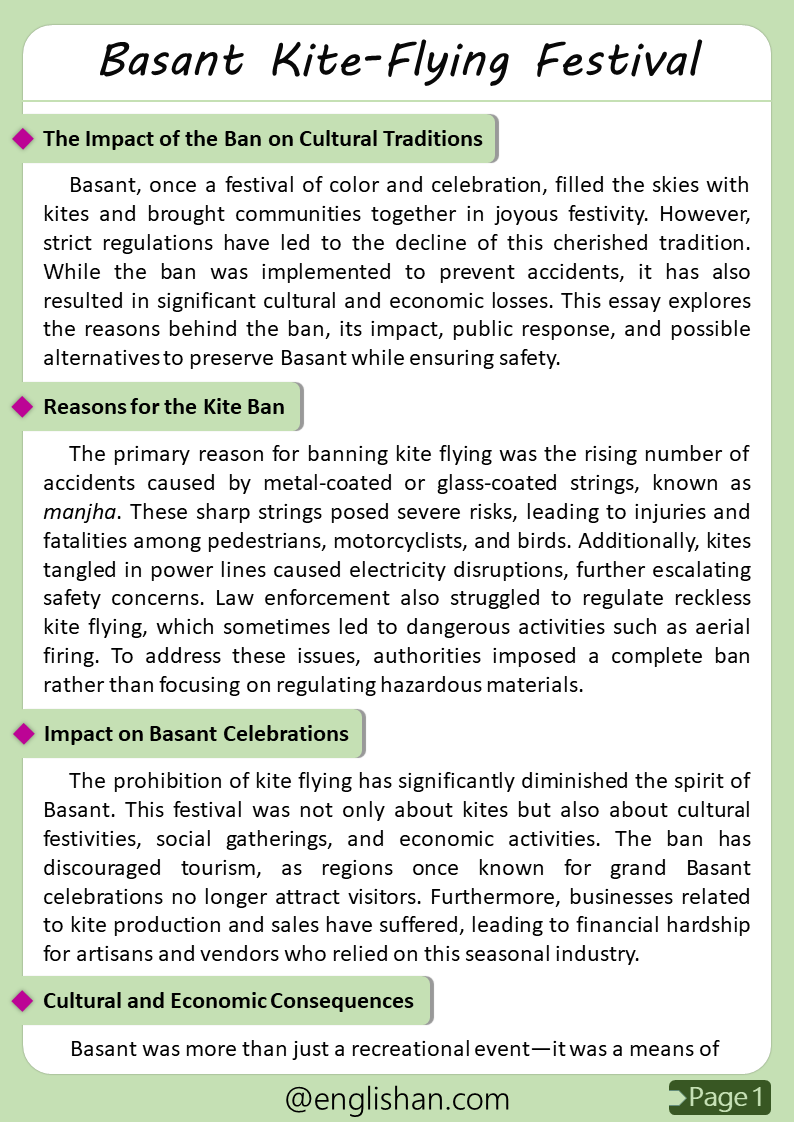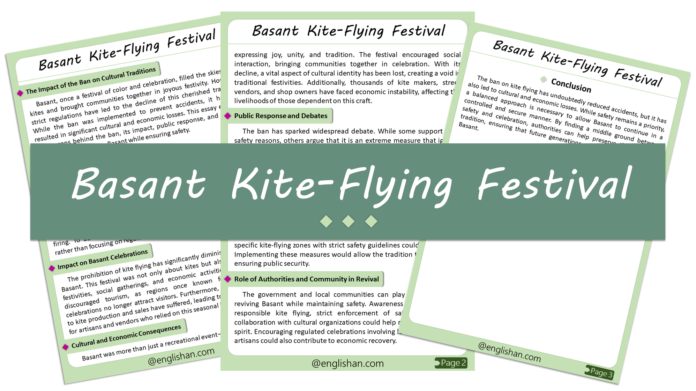Contents
When writing a Basant Kite-Flying Festival Essay, it’s important to understand how people celebrate the arrival of spring with color and joy. This essay on the Basant festival explains its meaning, common traditions, cultural importance, good and bad effects of kite flying, and safe ways to enjoy it. It’s written in 500 words to help students with homework or exams. You can download this Basant Kite-Flying Festival Essay as a free PDF or image to study or print.
10 Lines Basant kite-flying festival essay Essay for Class 2 to Class 5
- Basant is a festival that celebrates the arrival of spring.
- It is mostly celebrated in Pakistan and some parts of India.
- People wear yellow clothes to mark the season.
- The sky is filled with colorful kites on this day.
- Children and adults enjoy flying kites from rooftops.
- Special foods like sweets and snacks are made at home.
- People play music and enjoy time with family and friends.
- Kite-flying competitions are held in many places.
- The festival spreads joy, color, and excitement.
- Basant is a happy time that brings people together.

250 Words Essay on Basant kite-flying festival essay for Middle School
The Basant kite-flying festival is a joyful celebration of spring. It is mostly observed in Pakistan and some parts of India, especially in the Punjab region. The festival marks the end of winter and the beginning of warmer, brighter days. People celebrate Basant with happiness and excitement, making it one of the most colorful events of the year.
On this day, people wear yellow clothes, which represent the color of blooming mustard flowers. The most popular activity is kite flying. From morning till evening, the sky is full of colorful kites of all shapes and sizes. Children and adults climb onto rooftops to fly kites and shout “Bo kata!” when they cut someone else’s kite.
Families prepare special foods, including sweets like jalebi and snacks like samosas. Music and dancing are also part of the celebration. In some areas, kite-flying competitions are organized, adding more fun to the day. People visit their friends and relatives to enjoy the day together.
Although Basant is a happy and festive time, it is important to fly kites safely and follow local rules. Sometimes kite strings can be dangerous, so using safe materials is important to avoid accidents.
In conclusion, the Basant kite-flying festival brings joy, energy, and a sense of togetherness. It is a bright symbol of spring and a time when people come together to enjoy the beauty of the season.
500 Words Basant kite-flying festival essay Essay for Upper Primary and Lower Secondary
The Impact of the Ban on Cultural Traditions
Basant, once a festival of color and celebration, filled the skies with kites and brought communities together in joyous festivity. However, strict regulations have led to the decline of this cherished tradition. While the ban was implemented to prevent accidents, it has also resulted in significant cultural and economic losses. This essay explores the reasons behind the ban, its impact, public response, and possible alternatives to preserve Basant while ensuring safety.
Reasons for the Kite Ban
The primary reason for banning kite flying was the rising number of accidents caused by metal-coated or glass-coated strings, known as manjha. These sharp strings posed severe risks, leading to injuries and fatalities among pedestrians, motorcyclists, and birds. Additionally, kites tangled in power lines caused electricity disruptions, further escalating safety concerns. Law enforcement also struggled to regulate reckless kite flying, which sometimes led to dangerous activities such as aerial firing. To address these issues, authorities imposed a complete ban rather than focusing on regulating hazardous materials.
Impact on Basant Celebrations
The prohibition of kite flying has significantly diminished the spirit of Basant. This festival was not only about kites but also about cultural festivities, social gatherings, and economic activities. The ban has discouraged tourism, as regions once known for grand Basant celebrations no longer attract visitors. Furthermore, businesses related to kite production and sales have suffered, leading to financial hardship for artisans and vendors who relied on this seasonal industry.
Cultural and Economic Consequences
Basant was more than just a recreational event—it was a means of expressing joy, unity, and tradition. The festival encouraged social interaction, bringing communities together in celebration. With its decline, a vital aspect of cultural identity has been lost, creating a void in traditional festivities. Additionally, thousands of kite makers, street vendors, and shop owners have faced economic instability, affecting the livelihoods of those dependent on this craft.
Public Response and Debates
The ban has sparked widespread debate. While some support it for safety reasons, others argue that it is an extreme measure that ignores the festival’s cultural significance. Critics suggest that instead of a complete prohibition, better regulations and safety measures should be introduced to allow Basant to continue without compromising public safety. For instance, banning only hazardous kite strings while permitting traditional kite flying could help preserve the festival.
Alternatives to the Kite Ban
Rather than enforcing a complete ban, authorities could introduce regulations to ensure safer kite flying. Measures such as banning dangerous manjha, promoting eco-friendly alternatives, and designating specific kite-flying zones with strict safety guidelines could reduce risks. Implementing these measures would allow the tradition to thrive while ensuring public security.
Role of Authorities and Community in Revival
The government and local communities can play a crucial role in reviving Basant while maintaining safety. Awareness campaigns about responsible kite flying, strict enforcement of safe materials, and collaboration with cultural organizations could help restore the festival’s spirit. Encouraging regulated celebrations involving local businesses and artisans could also contribute to economic recovery.
Conclusion
The ban on kite flying has undoubtedly reduced accidents, but it has also led to cultural and economic losses. While safety remains a priority, a balanced approach is necessary to allow Basant to continue in a controlled and secure manner. By finding a middle ground between safety and celebration, authorities can help preserve this cherished tradition, ensuring that future generations can experience the joy of Basant.

Basant Kite-Flying Festival Essay PDF
You May Also Like
